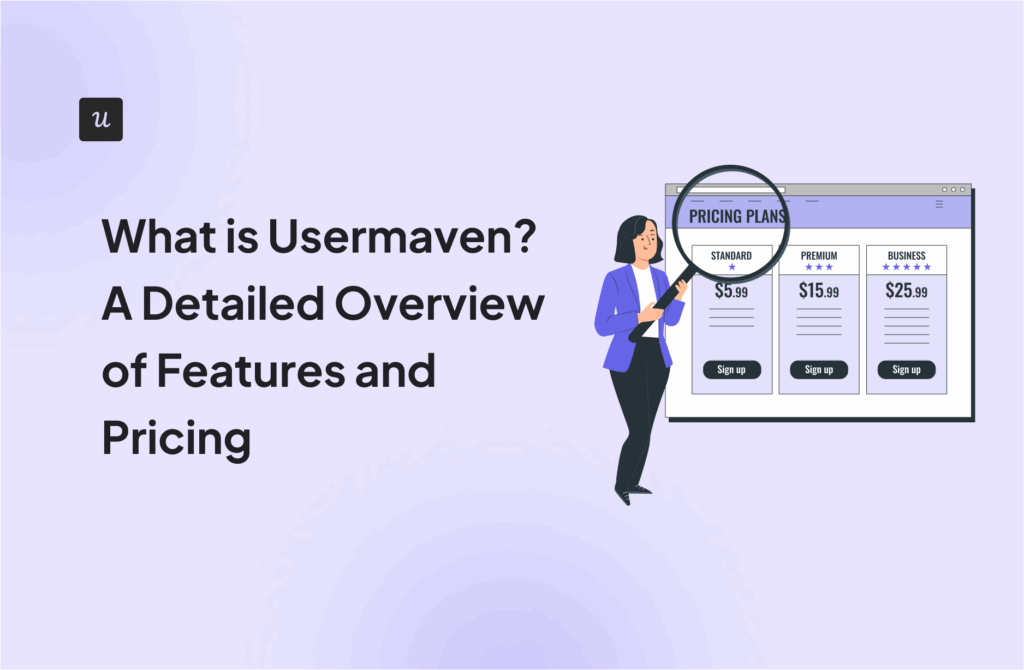
This guide digs into Pendo vs Chameleon to see which handles user onboarding and product analytics better in real time. It also shows why teams switch to Userpilot from Pendo.
In this article, we will explore the best alternatives for product adoption platforms, compared to Pendo and Chameleon. My goal will be to help you pick a platform that makes the onboarding experience smoother and user engagement sky-high.
Try Userpilot Now
See Why 1,000+ Teams Choose Userpilot

Pendo Overview
Pendo is a software experience management (SXM) platform that helps you create engaging and interactive in-app experiences for users and employees without writing a line of code.
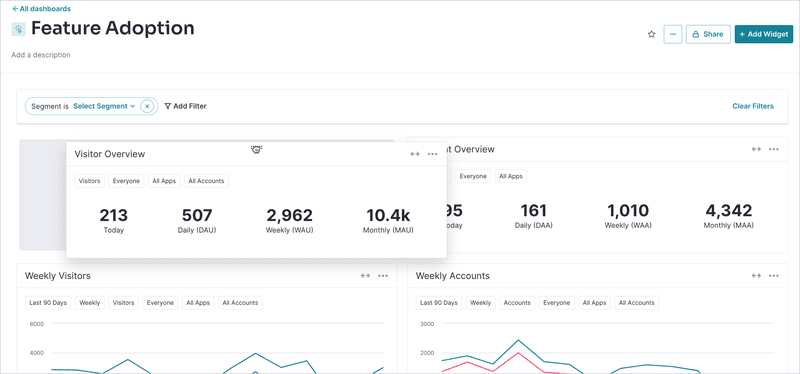
However, some users have reported on G2 that Pendo is buggy and lacks depth in managing feedback, which makes me question if it’s always this way for quick interactions.
Pendo does provide tracking on several data points and event properties but it’s often inconsistent where you can apply and access those within their dashboards and reporting tools. — G2 Review
Main use cases
Pendo is used for:
- Product Analytics & User Behavior Tracking: Pendo Analytics helps you identify invisible friction, uncover features your users love (or ignore), accelerate adoption, and improve software experiences. The platform captures comprehensive user behavior data automatically without requiring manual tagging of features or events.
- Product Adoption & Engagement: Pendo’s primary use cases are product adoption, analytics, and customer experience. Teams use Pendo to understand how users engage with their product and drive better adoption rates.
- Customer Experience Management: With Pendo, you can optimize the entire software experience to drive adoption and improve engagement.
I’ve discovered users don’t like Pendo if they have an evolving product that requires flexibility:
While certain capabilities/functionality may be there, the presentation/interface is old (think Salesforce, even Lightning). Pendo is not simple to set up and configure; dedicated resources are needed to setup/manage. Most importantly, Pendo is not a great solution for a company (e.g. like a Series A) that is rapidly evolving and requires flexibility. Their pricing/licensing model is inflexible and old school. E.g. as of this writing when you go to their pricing page you get a “request pricing” button instead actual information. Similarly, when my company wanted to transition off Pendo and asked for a 1-2 months extra time to facilitate, I was told that they only do 1 year contracts. Only after repeated escalations was I begrudgingly given option for a 3 month term. — G2 Review
Main features
Notable Pendo features:
- Retroactive analysis: Pendo offers retroactive analysis to extract insights from logged data later. With the help of Autocapture, you can pull insights on events you didn’t plan to track initially. However, Pendo’s autocapture is limited to page views and basic feature clicks.
- Feature usage: Pendo tracks which parts of your app are used the most or are ignored. Pendo isn’t designed for deeper product analytics, so the usage data won’t be detailed.
- User segmentation: Pendo groups users based on behavior or properties so that you can send targeted messages or guides only to specific user groups, logically. It’s not always straightforward, as you’ll be required to manually tag metadata.
- Friction reduction: Pendo uses session replays and paths to identify where users get stuck or drop off in your product. But session replays are available either as an add-on or in higher-tier plans.
- Knowledge base integrations: Pendo allows you to deliver contextual and on-demand help articles for your users. You can use knowledge base providers like Zendesk, WordPress, and HelpDocs.
Pendo does not automatically exclude or manage decommissioned accounts, which can lead to inflated or misleading user data unless handled manually. — G2 Review
Most used by
Pendo is mostly used by product managers, customer support/success teams, marketers, and UX folks from mid to large companies.
Pricing
Pendo provides a free plan with 500 MAUs that gives basic analytics and guides. This makes Pendo’s free plan a “glorified trial”.
The cost ramps up significantly as your MAU (Monthly Active Users) increase, making it feel like you’re penalized for product growth. — G2 Review
I feel this is a steep hill to climb if you’re not an enterprise-level SaaS brand, especially when G2 users complain about the limited value for money, poor implementation of customization, and inconsistencies in UI.
Because Userpilot is easier to configure and to work with, I’m getting much more value than with Pendo. – Leyre Iniguez, Customer Experience Lead, Cuvama
Limitations of Pendo
You can use Pendo to track user behavior, but it often falls short in setup and daily use. These limitations show up in reviews and hands-on work, making it worth a closer look at Pendo alternatives.
- Pendo has a complex setup and a complex UI that can be overwhelming for new users. An extensive feature set may lead to underutilization of the product’s capabilities and may not meet user needs.
- CSS/JS hooks, metadata setup, and segmenting users often require developer support. The technical setup requires a too steep learning curve even for basic reporting to get up and running. The value doesn’t justify the high pricing point and steep learning curve.
- Core digital adoption features like NPS in Pendo analytics, branching logic, AI, and resource center are offered as separate add-ons. Different parts of Pendo have different controls and processes. This inconsistency makes Pendo’s customers’ onboarding harder, let alone yours.
- Reporting is split across Data Explorer, Guides, Listen, and Dashboard. This can slow the time to insights. Even Surveys and NPS live in different modules. A user reported that the limitations made them switch to another vendor.
- Expect longer setup times, higher operational costs, and data discrepancies due to a third-party integration. More integrations, more discrepancies.
We ran into serious bugs that have not been addressed by Pendo and there are better analytics platforms. — G2 Review
Chameleon Overview
Chameleon is a product-adoption platform for SaaS teams that lets PMs build in-app product tours, tooltips, hotspots, and checklists with a no-code Google Chrome extension. It allows precise triggers, segment targeting, completion tracking, and sends the data to third-party integrations like Mixpanel or Amplitude.
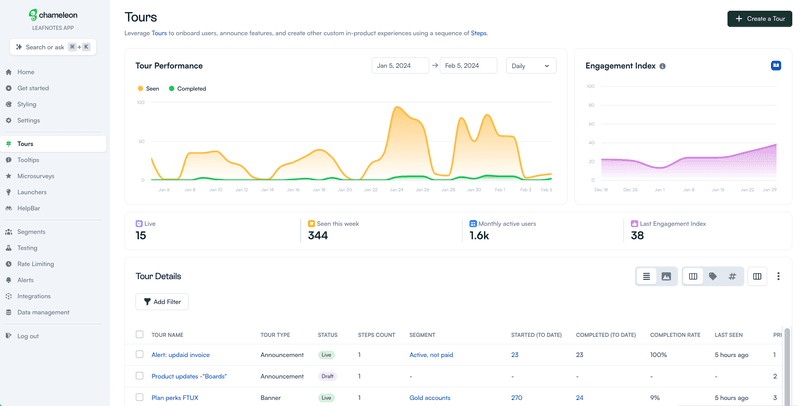
Main use cases
Chameleon is mostly used for:
- User onboarding: Set up tours, interactive guides, and checklists to guide users through the signup and basic account setup process, directly impacting onboarding experiences.
- Feature adoption: Use targeted toolips and in-app messages to point users to underused features for their profile/account.
- User feedback: Place microsurveys within the app to collect quick responses on user experiences and self-help guides to cut down on support questions.
There is a lot of complexity associated with building and publishing assets. At times it can be confusing. — G2 Review
Main features
Core features of Chameleon include:
- Build in-app guidance: Create tours, tooltips, modals, checklists, and microsurveys without needing to code them from scratch.
- Target the right users: Show each experience at the right time only to users who match the specific rules you set.
- Measure and improve: View completion, click through, and drop-off stats in one dashboard.
- Data & integrations: Sync events and user properties with tools like Segment, Amplitude, or HubSpot for deeper analysis and messaging.
Furthermore, reporting isn’t their strongest.
The reporting is not great and “goal setting” is not particularly effective. — G2 Review
Chameleon’s dashboards can feel clunky for quick checks.
The analytics dashboard, while functional, could be more intuitive and offer deeper insights. This is fine for us as we mainly stream Chameleon Data to our Product Analytics tool but its worth mentioning. — G2 Review
Most used by
Chameleon is used by product marketing managers, growth, and customer success teams. They usually gather product usage data from the product tours by using these tools.
Pricing
Chameleon pricing starts at $279/month for basic feature adoption tools like tours and 5 microsurveys. The very next plan costs $12,000/month. Also, the average operational cost of using Chameleon is $26,500 and can range up to $80,750.
Limitations of Chameleon
- Chameleon lacks detailed product analytics, and this means you’ll either have to rely on third-party integrations or upgrade to a plan to access basic in-app experience features like tracking tours. You’ll often find yourself pulling data from elsewhere to see how user onboarding is really performing.
- Setting up feedback forms isn’t as seamless as you’d like. These may not easily integrate with all third-party tools, forcing you to take extra steps. To make it worse, you only get 5 micro surveys for $279/month.
- Network security can be a hassle, especially if you manage a ton of user data. Chameleon’s setup doesn’t always enable tight security controls out of the box. This raises concerns for business accounts handling sensitive user behavior data.
- The pricing starts at a free plan, but it quickly loses value as you scale. Once you hit growth tiers, costs jump without adding much to core capabilities like advanced integration options.
A better alternative: Userpilot
Userpilot is a product management tool that helps you set up in-app guidance like tooltips, modals for mobile and web apps, right from one dashboard. You can also create email drips for product awareness and adoption from within the Userpilot dashboard. Userpilot places product satisfaction surveys like NPS and CSAT within your users’ path and journey to maximize engagement and receive timely feedback.
It targets specific groups (segmented), pulling the feedback given by the users in those survey forms without any extra tools, add-ons, or support. All this, unlike Pendo’s & Chameleon’s reliance on third-party integrations or paid add-ons.
Core features Userpilot offers:
- No-code onboarding: Set up tooltips and modals from the dashboard to create onboarding flows, no dev hours required.
- In-app surveys: Place NPS/CSAT forms in user paths for timely feedback without integrations.
- Funnel analysis: Check drop-offs in user journeys to fix bottlenecks.
- Session replay: Watch recordings of user sessions to spot UI related issues.
- Feature tagging: Monitor clicks and usage on tagged elements to see the feature adoption.
- User segmentation: Group by behavior or attributes for targeted tests.
- Retention reports: Track cohort return rates to measure stickiness of your product.
- Dashboards: View real-time metrics like active users for quick calls.
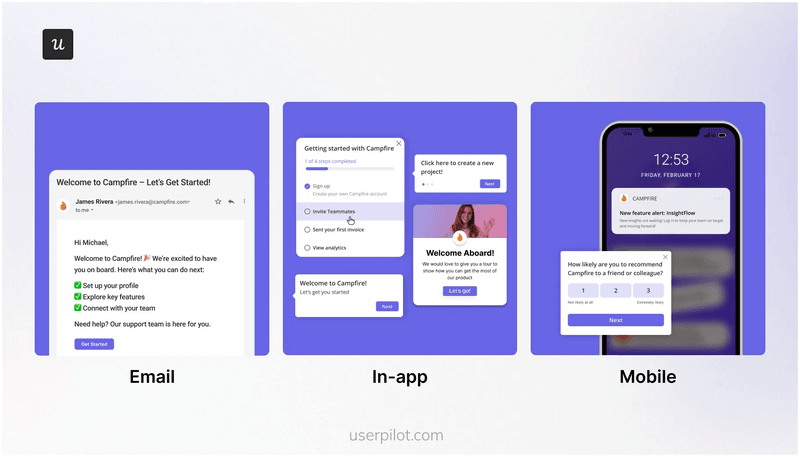
With Userpilot, you get robust product analytics focused on user actions, onboarding completion rates, and feature engagement, without overwhelming dashboards or fragmenting data across modules. This ensures your business gets quick, clear insights and hence sales, every time.
Also, Userpilot’s segmenting enables targeting users or companies for custom messaging without messy manual tagging or technical setup. Userpilot lets you focus on capabilities and business outcomes, not setup. Testing flows in staging versus production is seamless, so you can confidently roll out new in-app experiences.
There’s no network security headache or surprise add-on bills like Pendo alternatives. Furthermore, security and reliability features are built in for both the web interface and mobile apps.
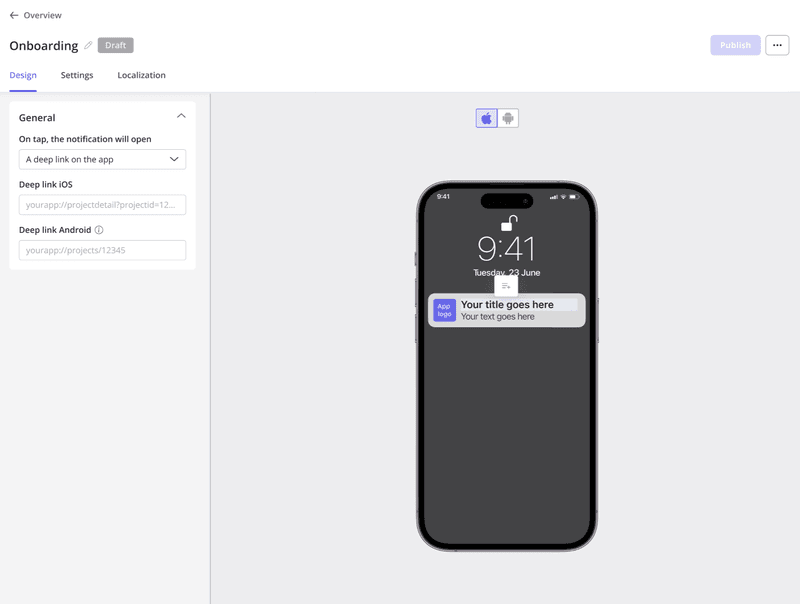
If you want value and transparency, we’ve proudly kept Userpilot’s pricing flat, clear, and free of hidden fees or unpredictable add-on costs. This makes it easy to budget and plan for account growth, giving you predictable value unlike others.
You can easily integrate Userpilot with your stack without jumping through technical hoops. For sales teams, the lack of complexity means quicker launches and responses to user needs, without spending weeks setting up guides because everything’s ready out of the box.
Lastly, if your focus is rapid iteration and reliable launches, Userpilot’s UI templates and session replay feature enable quick insights and troubleshooting, which Chameleon and Pendo can’t deliver as easily without developer or add-on expenses.
But don’t take my word for it, look what one of our customer (who switched from Pendo) have to say about their experience using Userpilot:
Switching from Pendo to Userpilot made our customer communication more effective and reduced our support workload significantly. — Matthew Brown, Senior Customer Solutions Manager, Shelterluv
Userpilot pricing: Transparent and feature-packed
Let’s start with upfront costs. Userpilot starts at $299/month for 2000 monthly active users, offering features like surveys, segmentation, and analytics without add-ons. Pendo hides the pricing and usually ranges between $14,650 to $145,083 per year while paying for add-ons for basic features like NPS & surveys. While Chameleon charges $279/month for super basic features, the very next plan is $12,000/month.
For your daily operations, you can consolidate guidance, analytics, and feedback into one Userpilot dashboard, avoiding Pendo’s fragmented modules and Chameleon’s reliance on third-party integrations.
As you scale, our MAU pricing aligns with your growth, with no surprise hikes, unlike Pendo and Chameleon’s unpredictable pricing.
Pendo vs Chameleon vs Userpilot: User feedback
Feedback collection shapes your roadmap, yet the ease of in-app engagement varies a lot. Let’s see which of Pendo, Chameleon, and Userpilot handles it best.
| Feature | Userpilot | Pendo | Chameleon |
|---|---|---|---|
| NPS | ✅ All tiers | ❌ Only in Pulse & Ultimate. Pendo-branded in the free plan | ❌ Available as microsurveys. Only 5 for the Startup plan ($279/mo) |
| Polls & Surveys | ✅ 30+ Customizable templates | ✅ Avaialble in all plans | ✅ Polls & Surveys are a part of Microsurveys, and only 5 are available for $279/mo |
| Analytics and Reporting | ✅ Built-in analytics at no extra add-on costs | ✅ Advanced reporting and analytics | ❌ Limited analytics even for $279/mo |
| Sentiment, Validation, and Product Roadmaps | Grouping by promoter/passive. ❌ No idea validation and product roadmap |
✅ Theme detection & trend alerts, idea validation, roadmaps (higher tiers only) | ❌ No built-in sentiment analysis or roadmap |
Pendo vs Chameleon vs Userpilot: Product Analytics
Product analytics reveal user patterns that drive decisions, but not all tools deliver depth without complexity. See how Pendo, Chameleon, and Userpilot measure up in the table below.
| Feature | Userpilot | Pendo | Chameleon |
|---|---|---|---|
| Event tracking | ✅ No-code event tracking, easy setup without developers | ✅ Automatic event tracking, but setup can be complex and needs dev support | ❌ Event tracking is available but lacks depth and flexibility. |
| Funnels & Paths | ✅ Built-in funnels with clear insights | ✅ Funnels and paths are available but doesn’t show KPIs like average time to complete the funnel | ❌ Basic funnel tracking |
| Segmentation & Targeting | ✅ Flexible segmentation without technical overhead | ✅ Good segmentation, but requires metadata | ✅ Segmentation exists, but lacks targeting options |
| Session Replay | ✅ Included with all plans & easy to use | ✅ Available only in the Core plan | ❌ No session replay |
| Dashboard & Reporting | ✅ Unified dashboard showing clear, actionable insights | ❌ No real time data sync. Data reflects after 15 minutes | ✅ Simplified reporting, but lacks integrations |
Pendo vs Chameleon vs Userpilot: Session Replay
Session replays expose hidden friction but only if the platform records and filters sessions well. Let’s see which of Pendo, Chameleon, and Userpilot delivers in the comparison table below.
| Feature | Userpilot | Pendo | Chameleon |
|---|---|---|---|
| Availability in standard plans | ✅ Included in all paid tiers, no extra add-on needed | ❌ Only on higher-end plans or as a paid add-on | ❌ No native session-replay, must integrate with Amplitude |
| Setup effort | ✅ One-click toggle – works after snippet install, no extra tagging | ❌ Requires additional script and metadata mapping to see events | ❌ Depends on third-party integration and custom code |
| Timeline linked to user actions | ✅ Replays auto-highlight clicks, hovers, and form events for quick troubleshooting | ❌ Only available in Core, Pulse, and Ultimate plans | ❌ Depends on third-party integration |
| Privacy / PII controls | ✅ Built-in field masking and role-based access to protect sensitive data | ✅ Masking is available, but managing it is a bit technical | ❌ Handled by whatever replay tool you connect |
| Sharing & collaboration | ✅ Copy a public link or download a clip for dev hand-offs | ✅ Collaborate and mention other Pendo users. Hidden behind a lot of technicalities | ❌ Depends on the external vendor. Often, there is no direct clip share |
Pendo vs Chameleon vs Userpilot: In-app engagement
In-app engagement can keep users within your app. The table below shows how Pendo, Chameleon, and Userpilot handle those make-or-break interactions.
| Feature | Userpilot | Pendo | Chameleon |
|---|---|---|---|
| No code creation | ✅ Truly no-code with ready-made UI templates | ❌ Requires some technical knowledge; complex setup | ❌ Limited no-code; requires dev involvement |
| Type of guidance | ✅ Tours, tooltips, hotspots, slideouts, modals. All no-code | ✅ Tours, tooltips, modals | ✅ Tours, tooltips, basic modals |
| Targeting & personalization | ✅ Flexible segmentation. Easy personalization | ❌ Good targeting, but requires metadata and segments | ✅ Basic targeting with some segmentation |
| Multi-device support | ✅ Strong multi-device support, including mobile | ❌ Supports web and mobile, but with limitations | ✅ Web-focused, limited mobile capabilities |
| A/B testing & analytics | ✅ Built-in A/B testing and clear performance analytics | ❌ A/B testing is available, but fragmented analytics | ✅ Available only for Growth & Enterprise plans |
Pendo vs Chameleon vs Userpilot: Mobile Engagement
Mobile engagement can tank if it’s chaotic on mobile phones, leading to quick drop-offs. Let’s see how Pendo, Chameleon, and Userpilot compare for real-world use.
| Feature | Userpilot | Pendo | Chameleon |
|---|---|---|---|
| Cross-Platform Support | ✅ Seamless experience on web and mobile | ✅ Supports web and mobile apps, but some mobile features are limited | ❌ Web-focused, limited mobile app support |
| Push Notifications | ✅ Full-fledged mobile push notification creation | ✅ Available but not straightforward | ❌ Only with third-party integrations |
| In-App Messaging | ✅ Rich in-app messaging including tooltips and guides | ❌ Available but limited or with add-ons | ✅ Simple in-app messages |
| Personalization & Targeting | ✅ Flexible user and account segmentation | ✅ Good targeting but needs metadata setup | ✅ Good targeting and personalization |
| Analytics & Reporting | ✅ Unified analytics across devices | ✅ Fragmented analytics, some manual tasks required | ✅ Minimal analytics for mobile |
Pendo vs Chameleon vs Userpilot: Integrations
Integrations matter when your tools need to talk seamlessly, but one platform here skips the dev hassle and extra costs. Let’s find out which one it is.
| Feature | Userpilot | Pendo | Chameleon |
|---|---|---|---|
| Number of native integrations | ✅ Good range with easy plug-and-play | ✅ Wide range but often needs developer help | ❌ Limited number of integrations |
| Ease of integration | ✅ No-code integration via UI, quick setup | ❌ Complex setup with metadata and tagging | ❌ Requires custom dev work for many |
| Data sync & automation | ✅ Real time user data sync | ❌ Supports data sync with 15 min lag | ❌ Basic data sync with delays |
| Security & compliance | ✅ Built-in security with easier compliance | ❌ Enterprise-grade security but complex | ❌ Security varies by integration |
| Customization & API access | ✅ Open API for custom workflows and hooks | ✅ Full API access available with permissions | ✅ API available but less flexible |
Pendo vs Chameleon vs Userpilot: Best fit scenarios
Let’s compare Pendo, Chameleon, and Userpilot to understand which tool is best for the top scenarios for product management.
| Scenario | Userpilot | Pendo | Chameleon |
|---|---|---|---|
| Launching new features quickly without dev help | ✅ Ideal – no-code UI templates to launch fast | ⚠️ Challenging setup requiring dev resources | ❌ Basic no-code, but limited flexibility |
| Collecting detailed user feedback and linking it to behavior | ✅ Strong – in-app feedback with linked user actions | ⚠️ Fragmented feedback tools locked behind add-ons | ⚠️ Feedback options are limited and less flexible |
| Scaling onboarding across multiple product lines or teams | ✅ Flexible – supports multiple teams and environments | ✅ Best for enterprise but complex for smaller teams | ✅ Suitable for midsize teams but limited scaling |
| Running personalized in-app campaigns and target segments | ✅ Powerful – advanced segmentation and targeting | ⚠️ Good targeting, but tied to metadata setups | ⚠️ Simple targeting with basic segmentation |
| Managing product adoption with clear ROI and insights | ✅ Transparent – analytics focused on real results | ⚠️ Detailed analytics, but complex to interpret | ⚠️ Basic analytics without deep insights |
| Budget-conscious product teams needing clear pricing | ✅ Predictable – flat pricing keeps budget in check | ❌ Expensive and opaque pricing model | ⚠️ Pricing quickly grows as the user base expands |
| Multi-device support for mobile and web users | ✅ Seamless – true multi-device support | ⚠️ Supports mobile but with limited features | ❌ Focused on web, weak mobile engagement |
When to choose Pendo?
Use Pendo when:
- Your enterprise team can handle complex setup and spend time on ongoing maintenance.
- Your team can climb the steep learning curve for deeper analytics.
- You have a budget for paid add-ons and modular features upgrades.
- You need built-in roadmaps tightly linked to user feedback.
- Your product stack requires heavy, API-driven custom integrations.
When to choose Chameleon?
Chameleon is fine when you need basic feedback collection with fewer distractions. Also, for mid-sized teams looking for straightforward onboarding tours that don’t need advanced analytics, Chameleon is the right choice.
I think it’s a decent choice if your users can feel guided using interactive guides like checklists and simple modals. Furthermore, if your focus is just on the web app and not the mobile experience, Chameleon is a great choice for your budget.
Speaking of budget, it can be a factor when startups prefer Chameleon initially, but I’d recommend keeping an eye on pricing, as it will get costly very fast to use a simple software for complex needs, and the way out isn’t easy.
When is Userpilot the better choice?
When you’re a part of a product-led growth company, you need to move fast, and Userpilot lets you implement onboarding workflow and in-app guidance in minutes without waiting on devs. As your company grows, you’ll find Userpilot scales easily, whether you’re managing small teams or large enterprises, keeping setup simple without losing key features.
If you want robust & straightforward tools, Userpilot strikes the right balance, giving you powerful capabilities without the clutter and complex setup that slow you down.
For me, speed and reliability matter more than flashy features that add bloat, and Userpilot consistently delivers smooth, dependable performance. If you’re switching from another platform, Userpilot’s seamless migration with bulk import options makes it easier to adopt without losing data or disrupting workflows.
When your team has limited technical resources, Userpilot’s true no-code approach empowers you to build and modify experiences independently, freeing you from developer bottlenecks. Still in doubt or have questions? I invite you to a Userpilot demo.
DISCLAIMER: Userpilot strives to provide accurate information to help businesses determine the best solution for their particular needs. Due to the dynamic nature of the industry, the features offered by Userpilot and others often change over time. The statements made in this article are accurate to the best of Userpilot’s knowledge as of its publication/most recent update on September 16, 2025.



